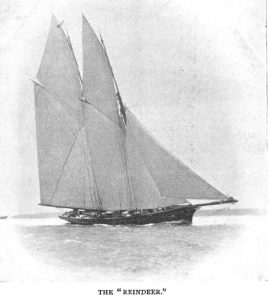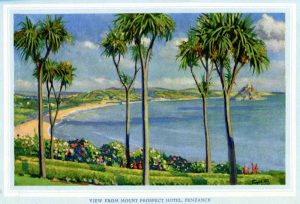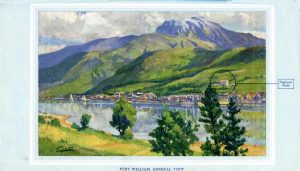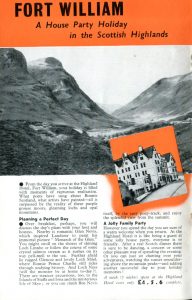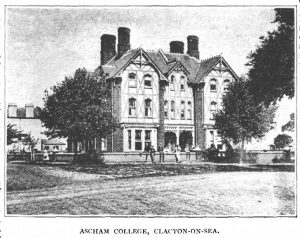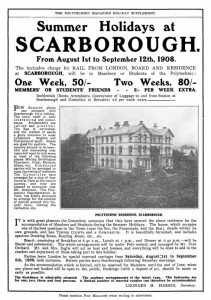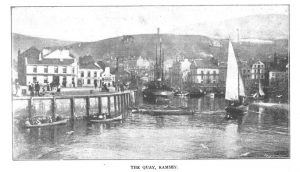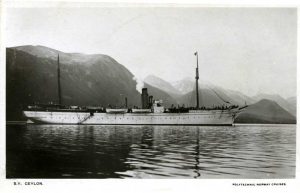Leading cryptocurrency exchange gate io
‘See the Best of Britain’: staycations with the PTA
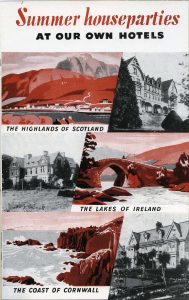
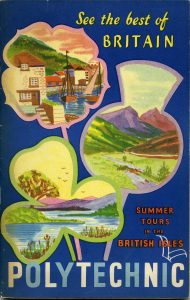
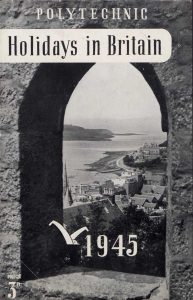
Legend has it that in 1888 Robert Mitchell, Secretary of the Polytechnic, overheard a geography lesson at the Regent Street Polytechnic. He quickly realised that not one of the boys in the class had seen the places or features they were learning about. He decided that a trip to the Continent was in order and 60 boys went on a tour of battlefields and on to Zermatt in the Swiss Alps.
Soon after, Mitchell came across some chalets for sale on Lake Lucerne in Switzerland and purchased them as a holiday destination for members of the Poly. Thus, the Polytechnic Touring Association (PTA) was born. Over the years, the PTA went from strength to strength offering holidays to locations from Norway to Algeria. Eventually, it became the ‘Poly’ part of Lunn Poly.
As the UK eases out of lockdown and UK holidays (albeit limited ones) are once again allowed, we have been delving into the archives in the hope of inspiring your wanderlust. Here a just a handful of the British staycations offered by the PTA over the years.
Isle of Wight and the Solent
‘With the Isle of Wight as a natural breakwater, the Solent forms a sheltered sea nearly one hundred square miles in extent…The water is clear as crystal and as blue as the Mediterranean, and on it are found watering places with mirth and music, cities with docks and shipping, men-of-war, ships of peace, and yachts of all rigs and tonnage.’ (Polytechnic Magazine, 22 June 1898)
In 1896, cruises on board the Reindeer, an 80 ton schooner, were arranged for Poly members. In 1901, the PTA purchased the Reindeer for sailing holidays around the Solent. Accommodating 25 people, the Reindeer was
‘most comfortably fitted…The sleeping accommodation is most comfortable for a yacht, and those desirous of taking part in a healthy, enjoyable and economic holiday of this character can do no better than book for this holiday’ (Polytechnic Magazine, 20 May 1901)
Places visited included Cowes, Totland Bay, The Needles and Hayling Island. Excursions on shore were made each day and the Reindeer was anchored in calm waters each night. In 1901, a week’s trip cost £2 10s. (approx. £200 today) for Poly members.
By the 1920’s, hotel based holidays were also advertised in Ventor and Shanklin.
Penzance
‘Combine an old-world fishing village with a modern holiday resort and you have Penzance, set amidst the flowers of the Land’s End district and in the centre of the legend-haunted villages of Cornwall. It occupies an unrivalled position, over-looking the exquisite beauty of Mount’s Bay and St Michael’s Mount’ (PTA Summer Brochure, 1939)
Opening Easter 1908, Mount Prospect Hotel was purchased by the PTA for use by Poly members. Offering sweeping views of the Bay, the hotel had 40 beds and was instantly popular. Upwards of 70 people were accommodated during its first Easter. In 1939, the Hotel was renovated and the following description was given
‘hot and cold running water in every bedroom…always a splendid dinner awaiting you and a concert, dance or entertainment which at last sends you to bed with the conviction that you have never before had such a completely happy day.’ (PTA Summer Brochure, 1939)
Excursions from Penzance were easy to come by, with motor and boat tours to Land’s End, St Ives, The Lizard, Falmouth, Mullion Cove and Newquay.
Other destinations in Cornwall and Devon offered by the PTA over the years included Newquay, Ilfracombe, Minehead and Torquay.
Fort William
‘Fort William overlooks an indescribably beautiful panorama of loch, moor and hills. To the North is the Great Glen, full of history with its tragedies and romances. In the West is the land of Bonnie Prince Charlie, where the mountains roll away…[to the South] little steamers glide down the winding Loch to Oban, clustered around its beautiful bay and out beyond the Isle of Mull to Staffa and the sacred Isle of Iona.’ (PTA Summer Brochure, 1939)
Used by the Polytechnic from the 1890’s and later purchased by the PTA, the Highland Hotel was described in the 1939 PTA Summer brochure as having a view that is ‘Scotland in a nutshell’. The hotel itself was descibed as having an exterior that was ‘stout and solid, the interior friendly and hospitable (again symbolic of everything Scottish)’. In 1939, a 7 night stay cost £4 5s. 6d. (approx. £220 today). The hotel had 120 bedrooms with hot and cold running water in each. Excursions by boat, train and car included visits to Inverness, Glencoe, Oban, Glen Nevis, and the Isles of Skye and Iona.
The hotel was requisitioned by the authorities during the Second World War but was back in use by the PTA in 1945.
Clacton-on-Sea
‘Not even war could spoil Clacton as a holiday desintation. It has so many natural advantages. The climate is mild yet bracing, with an abundance of bright sunshine.’ (PTA brochure, 1945)
Clacton-on-Sea was one of the first destinations where the Polytechnic secured the use of a holiday home for its members. In 1890, Ascham College provided accommodation for 30 people each week and boasted sea views, a cricket and lawn tennis ground immediately adjoining the house. Members could travel by land or by water to get there. Arrangements were made with the Victoria Steamboat Company to travel by boat
‘our excursionists will, therefore, be able to travel by the “Clacton Belle”, first-class return tickets for the journey being obtainable at the Poly at the reduced price of 4s. 6d. By this means a very enjoyable sea trip is added to the other manifold attractions of the holiday’. (Polytechnic Magazine, 29th May 1891)
Clacton was still being recommended as a holiday destination in the 1945 brochure with ‘magnificent sea bathing… many diversions for the young, as well as lovely gardens and fine promenades for those who desire quiet enjoyment.’
During the 1890’s the Poly tried to offer a variety of holiday homes. Some people wanted a change from Clacton-on-Sea and so a home was found in Weston-Super-Mare. However, with its origins as a working-class institution, some Poly members found Weston-Super-Mare too expensive. Other homes were found in Hastings, Brighton, Eastbourne, Folkestone and Ramsgate.
Scarborough
‘On a wooded headland between two beautiful bays lies Scarborough, the “Queen of the North”. Around its foot, and skirting vast stretches of golden sands, is the Marine Drive, one of the finest sea promenades in Europe…The spa is lavish in its provision of sporting facilities and entertainments.’ (PTA Brochure, 1945)
In 1904, the Governors of the Polytechnic secured a house called Orleton as a Holiday Home for members to use during the Summer. It was situated in the ‘southern and most fashionable part of the town’. The house included a billiard room, gymnasium, and tennis courts.
Scarborough continued to be promoted by the PTA over the years with the 1947 PTA brochure highlighting its sandy beach, golf, tennis and bowls, fishing from the pier and evening entertainments. Excursions from the town included trips to Whitby, Rievaulx Abbey, Filey and Bridlington.
Isle of Man
‘The Isle of Man is a country whose dominant colour is grass-green, which is broken during the summer by a blaze of gold, the gold of the gorse and the fuchsia – a fairyland of wooded glens bright with wild flowers and sweet scent of the briar – an island of mountains where rushing rivers tumble down to the sea’. (PTA brochure, 1947)
As early as 1898, the Polytechnic was offering a week’s holiday in the Isle of Man for 3 guineas (approx. £260 today). Travelling by rail from London to Liverpool and then by steamer to Douglas, where tourists would be based, daily excursions included trips to Kirk Bradden, Snaefell, Ramsey and Peel, Castletown and Port Erin, and a steamer trip round the island.
In 1899, the Old Manor House, 10 minutes from the centre of Ramsey was leased for the holidays. Many of the holiday homes offered by the Poly in the 1890’s were aimed at men or women rather than accommodating both sexes. Nevertheless, ‘a limited number of rooms [were] set aside for married members and their wives’.
Cruise Around the British Isles
While a cruise may not be everyone’s first choice in the age of Covid-19, in 1898 the PTA offered a 13 day trip round the UK and Ireland for 9 guineas and it proved very popular. It took in destinations and sites such as Plymouth, Killarney, The Giants’ Causeway, Skye, the Forth Bridge, and Edinburgh before finishing in Grimsby or Harwich.
The cruise was on board the SY Ceylon, a former P&O steam yacht purchased by the Poly in 1895, specifically for the purpose of providing cruises to Norway. The yacht had 49 berths and was owned by the Poly until 1907.
Further Reading
For a more in depth look at the significant role the PTA played in the history of tourism, read Neil Matthews’ chapter of Educating Mind, Body and Spirit, available to download for free from the University of Westminster Press
Students and staff of the University of Westminster can access digitised versions of the PTA collection via the Leisure, Travel & Mass Culture: The History of Tourism website, produced by Adam Matthew Digital. Details of how to access the resource from home can be found here.
The PTA collection can be found on our catalogue here.
(Currency conversions based on The National Archives currency converter calculations)
Claire Brunnen, April 2021
